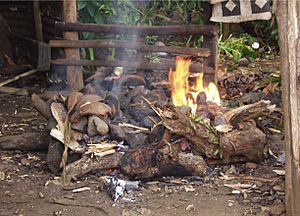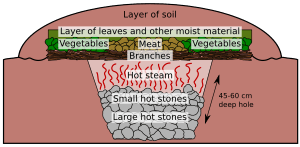Earth oven facts for kids
An earth oven is a super old and simple way to cook food. It's basically a hole in the ground that traps heat to bake, smoke, or steam your meal. People all over the world have used earth ovens for thousands of years. Finding these cooking pits helps archaeologists learn about ancient human settlements. Even today, earth ovens are great for cooking large amounts of food, especially when you don't have modern kitchen tools. They are still very common in the Pacific region.
To cook food, you first build a fire in the pit. You let the fire burn down until only hot coals are left. Then, you place the food inside and cover it up. This covered space can bake things like bread. For steaming food, you put fire-heated rocks into the pit. Then you add green plants on top to create moisture, followed by lots of food. More green plants and sometimes water are added if needed. Finally, you cover everything with earth. The food can take several hours or even a whole day to cook, whether you're baking or steaming.
Many communities still use earth ovens for special events and celebrations. Some famous examples include the Fijian lovo, the Hawaiian imu, the Māori hāngi, the Mexican barbacoa, and the New England clambake. The Central Asian tandoor oven is a bit like an earth oven, but it's a permanent clay or brick structure with a constant hot fire at the bottom.
Contents
Earth Ovens in the Americas
Archaeologists have found many "pit-hearths" in the Americas, showing how common earth ovens were long ago. In Central Texas, there are huge piles of "burned rocks." Experts think these were used for cooking large amounts of plants, like the bulbs of sotol. The Mayan pib and Andean watia are other examples of earth ovens.
Mexican Barbacoa
In Mesoamerica and the Caribbean, barbacoa is a popular cooking method. The word barbacoa originally came from the Taino people and referred to the pit itself. This method involves slow-roasting meat in a pit lined with maguey leaves. It's very popular in Mexico, often served with birria, tortillas, and salsa.
New England Clambake
The clambake was invented by Native Americans on the Atlantic coast. It's a traditional part of New England food. People usually build these earth ovens on a beach. They dig a big hole in the sand and put heated rocks at the bottom. Then, a layer of seaweed goes on top to create steam. After that, the food, mostly shellfish and vegetables, is added. Finally, another layer of seaweed covers everything to trap the steam and cook the meal.
South American Huatia and Curanto
The curanto from the Chiloé Archipelago in Chile is a mix of shellfish, meat, potatoes, and vegetables. It's traditionally cooked in an earth oven and has spread to other southern parts of Chile.
The huatia (or watia) and pachamanca are traditional earth ovens from the Andean regions of Peru, Bolivia, and Chile. These cooking methods were used by native people even before the Inca Empire.
Earth Ovens in Asia
The Hakka people of China, who live in special round houses called tulou, have also been known to use earth ovens for cooking.
Earth Ovens in the Middle East and North Africa
Earth oven cooking is sometimes used for celebrations in North Africa, especially Morocco. A whole lamb might be cooked in an earth oven called a tandir. This is similar to the Hawaiian kalua method.
Among Bedouin and Tuareg nomads, a simple earth oven is often used when men travel alone in the desert. They mostly use it to bake bread, but also to cook venison (deer meat) or waran (a type of lizard). To bake bread, they mix wheat or barley flour with water and salt. Then, they place the dough directly into the hot sand under a campfire. Hot coals cover it, and it's left to bake. This bread, called Arbut, is eaten with black tea. Sometimes, people mix the bread with melted fat or labneh (goat milk yogurt) before eating it.
Earth Ovens in the Pacific and Madagascar
Earth oven cooking was very common in the past in the Pacific and is still used today for special events. This is because preparing an earth oven takes a lot of effort.
In many Melanesian, Polynesian, and related languages, the general word for earth oven is "umu." For example, it's ʻumu in Tongan, umu or hāngi in Māori, imu in Hawaiian, and umu in Sāmoan. However, other islands use different words. In Fiji, it's a lovo; in Rotuman, it's a koua; and in Tahiti, it's an ahima'a.
In Papua New Guinea, people who speak Tok Pisin or English use the word "mumu." But each of the hundreds of local languages has its own word. In the Solomon Islands, the word in Pidgin is Motu.
Even with similarities, there are many differences in how earth ovens are prepared, their cultural meaning, and how they are used today. Some believe earth ovens first started in Papua New Guinea and were later adopted by Polynesians.
Samoan Umu
The Samoan umu cooks food in a similar way to other earth ovens. It's very much like the Hawaiian imu. While the imu is usually dug underground, the umu is generally built above ground. It's a common way to roast foods every day, especially since modern ovens are mostly found in Western-style houses. In a traditional village house, gas burners might be used inside for cooking in pots. The umu is often under a roof to protect it from rain, and it's separate from the main house. It has no walls, so smoke can easily escape.
To start a Samoan umu, a fire is built to heat rocks. These rocks are chosen carefully to make sure they won't explode when heated. They are used many times but are replaced when they don't hold enough heat anymore. Once the rocks are hot, they are stacked around food parcels wrapped in banana leaves or aluminum foil. More leaves are placed over everything, and the food cooks for a few hours until it's ready.
Hawaiian Imu
The Hawaiian imu was the easiest way for Hawaiians to cook large amounts of food quickly. Because they took so much work to create, imus were only made for special events or ceremonies. To make an imu, you first dig a hole about 2 to 4 feet deep. Porous rocks are heated and then placed at the bottom of the pit. Next, a layer of banana tree stumps and banana leaves is added on top of the rocks. After the plants are laid down, meat, fish, and other foods are placed on top. Then, they are covered again with more plants. Sometimes, wet cocoa sacks are also added on top to create even more moisture and trap heat.
Earth Ovens in Europe
In Europe, earth ovens were used starting in the Neolithic period (the New Stone Age). Examples have been found at sites like Rinyo and Links of Notland on Orkney. They became more common in the Bronze and Iron Ages at places such as Trethellan Farm, Newquay, and Maiden Castle, Dorset. Many "pot boilers" from ancient British sites are now thought to be leftover rocks from cooking with stones, similar to a Polynesian oven. European earth ovens from ancient times varied in shape but were generally bowl-shaped and not very deep (about 30–45 cm), with widths between 0.5 and 2 meters.
One special example is the Irish Fulacht fiadh, which was commonly used up to the Middle Ages. In Greek cuisine, there's a tradition of kleftiko ("thief style") dishes. These dishes are said to have been made by anti-Turkish fighters during the Greek War of Independence. They would wrap food in clay and cook it in a covered pit, supposedly to avoid being found by Turkish forces.
See also
 In Spanish: Horno de tierra para niños
In Spanish: Horno de tierra para niños




